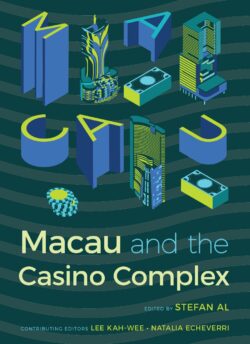Macau and the Casino Complex
Edited by Stefan Al. Contributing Editors: Lee Kah-Wee And Natalia Echeverri; University of Nevada Press, 2018 224pp

Stefan Al’s latest book Macau and the Casino Complex is the latest in his collection of seemingly bi-annual publications capturing the special urban conditions emerging in the Pearl River Delta. It follows Factory Towns of South China (2012), Villages in the City (2014), and Mall City (2016). These books serve as great primers in the particularities of each of these urban environments. He seems to be perfecting a new type of easily accessible, graphically rich, wittily worded publication that does a quick, deep dive into an urban form and its context and manages to speak both to the professional and the engaged everyday citizen. They are a kind of coffee table book with depth, or perhaps a magazine 2.0—a new kind of hybrid publication. Whatever label you want to thrust upon them, they serve as ideal introductions to the realities of these urban spaces.
Macau and the Casino Complex brings together a variety of voices to speak on the array of contexts and lessons one can glean through close examination of this phenomenon. Cathryn H. Clayton’s “Petri-Dish Urbanism” piece in the book is good at contextualizing this within Macau’s long embrace of a boom and bust economy, while Tim Simpson identifies this “laboratory of consumption” as a training ground sited within Chinese society’s rapidly shifting post-communist ideology. Kah-Wee Lee digs even further back into this perceived cultural legacy of gambling in dark opium dens and exposes how those misguided orientalist stereotypes make for a blunt capitalist tool that allows these urban forms to flourish. Desmond Lam goes on to look at how feng shui is used to [de]form the spatial elements within the city. HK Urbex and the piece by He and Siu give concrete data on the economic impact of these developments and specific case studies of how they have been perceived and treated over time.
Obviously within the discourse of city form and gambling destinations one has to speak to the iconic Learning from Las Vegas by Robert Venturi, Denise Scott Brown, and Steven Izenour. It is of note, that Al himself has (yet another) book speaking to the significance of Vegas in relation to America itself. It illuminates how “the strip” has evolved spatially, but also gives greater nuance to the economic and cultural context framing these formal evolutions. While Learning from Las Vegas attempts to suggest an emergent singular formal language, Thomas Daniell’s chapter picks up on the urban discourse put forth by Venturi/Brown and illustrates that Macau is an example of a “collage city.” Thus Macao reads as a study in diverse forms slammed against one another. It depicts in built examples what Rem Koolhaas alluded to when he spoke of the Pearl River Delta being a “city of exacerbated difference” some 20 years ago.
Reading the text of Timothy Luke, and some of Al’s, we can situate them within recent urban development discourse and highlight their identification of a new development model of “casinopolitanism” as particularly resonant. The opening of the Hudson Yards development in New York and the headline- and eye-grabbing elements of Thomas Heatherwick’s sculpture there, “The Vessel” and Diller Scofidio’s arts center, “The Shed” have framed a discussion of “complex developments” that include the allure of sleek forms, luxury culture, and celebrity culinary experiences but exclude the complexities of the everyday. This “Mimosa Manhattanism” is a cocktail of urban density and intensity with a splash of velvet ropes that can be seen in Macau, Dubai, and in a city near you.
The book’s text and graphics do a superb job of juggling expertise and playfulness to pull the curtain aside and expose what really lies behind these new and pervasive developments. Macau may seem like a silly excursion to many or even a joke to others, but Stefan Al and his cowriters are pointing out that these forms are not one-offs, but instead are perhaps the canaries in the coal mine for what is a new form of global development that is rapidly being deployed in the Chinese cultural sphere and beyond.



